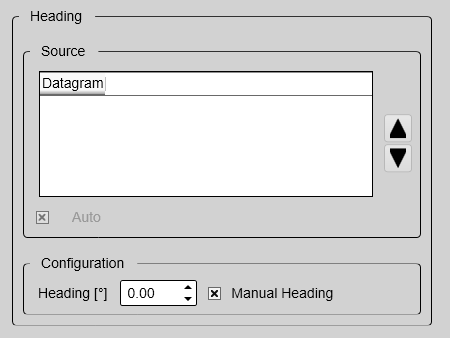Sensor Configuration page
With multiple sensors connected to the ST90 system, many of them will provide the same datagrams. We cannot expect that these datagrams provide the same information. The Sensor Configuration page allows you to define a datagram priority, so that the information from the "most reliable" sensor is used by the ST90 system. You can also define manual values in case a sensor is unserviceable, or not installed.
How to open
This page is located in the Installation dialog box. To open the page, select Installation on the Setup menu.

Prerequisites
The Installation dialog box is not available when your ST90 system is set to Replay mode.

Description
When the ST90 system communicates with peripheral devices (for example, navigation sensors), the information is contained in datagrams. The term datagram has been defined as follows:
A self-contained, independent entity of data carrying sufficient information to be routed from the source to the destination computer without reliance on earlier exchanges between this source and destination computer and the transporting network.
https://tools.ietf.org/html/rfc1594, April 2016
The majority of the datagrams used by the ST90 system are defined by the National Marine Electronics Association (NMEA). Other proprietary datagrams are defined by third-party organizations or by Kongsberg Discovery.
Any information in a datagram, for example, the vessel speed, may be provided in different datagrams from several sensors. Due to several reasons (environmental conditions, installation, configuration, accuracy, etc.), the numerical values provided can be different from one sensor to another.
Several sensor are provided on the Sensor Configuration page, one for each type of information. Select the sensor you wish to configure in the Sensor list. For each type, you can define a priority sensor by rearranging the datagrams in a list. You can also define manual values in case a sensor is unserviceable, or not installed.
The ST90 system can communicate with several different sensor types. Use the Sensor Installation page to define which external sensors your ST90 system will import information from. You must also specify which datagram formats to use. The Sensor Installation page is located in the Installation dialog box.
A summary of all the sensors that are connected to the ST90 system is provided in the Diagnostics dialog box.
When you save echo data in RAW format, all sensor data are included.
If you have two sensors providing the same information, but on different communication ports, certain limitations apply. During normal operation, you can easily decide which sensor you wish to use. During replay, you can only play back from one of these sensors. For this reason, only the information from the currently "active" sensor is saved.
When you work in the Installation dialog box, you must always select Apply to save the changes made on a page. You must do this before you continue working on a different page.
Details
- Sensor
All the sensors are listed. Select a sensor in this list to set up the datagram priority and/or configuration.
Tip:You can set up datagram priorities for both heading and course information on the Sensor Configuration page. The course information is used to present the Course line in the relevant views. When enabled, the vessel's current heading is shown on the top bar. If the information from the heading sensor fails, the top bar will change to present the course information instead.
- Auto
Select Auto to control the functionality.
- With Auto enabled, the priority list is used. Information is imported from the sensor at the top of the list. If the sensor fails to provide information for more than 20 seconds, data from the next sensor is used.
- With Auto disabled, the priority list is not used. Information is imported from the sensor at the top of the list. All other sensors are ignored.
- Source
The Source list presents all the datagrams that you have selected to provide input data. Use the two large arrows to move the selected datagram up or down the priority list.
- Configuration
For most sensors, you can specify a manual value. Use this functionality if a sensor is unserviceable or not installed. Check this box to enable the function. Select or type the requested value.

- Time
When you select the Time sensor, you can set the ZDA datagram to synchronize the internal clock in the Processor Unit. To do this, you need administrative privileges on your Processor Unit.
- Position
Instead of using the input from your positioning system, you can use manual position values. The position information on the top bar is in yellow if you use manual values. The latitude and longitude values on the page display the latest position received from the positioning system. You can use these as a starting point for the manual position or define other specific values. If you have enabled the speed input, the ST90 system will use dead reckoning to estimate new positions.
